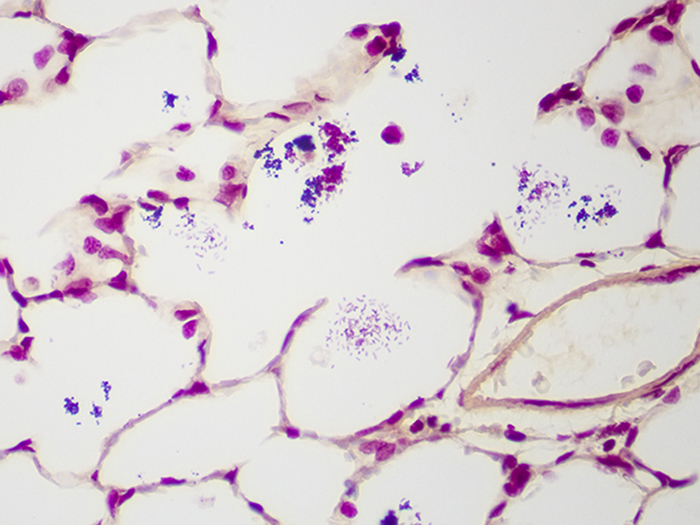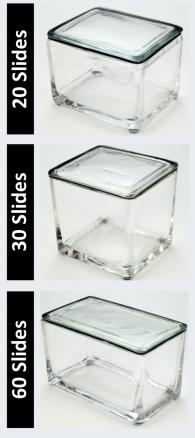Gram, Brown-Hopps Stain Kit
Stains gram-negative and gram-positive bacteria and uses Gallego solution to differentiate the organisms.
GRAM, BROWN-HOPPS STAIN KIT INCLUDES:
| Part 9124A | ||
| Solution A: | Crystal Violet Stain 1%, Aqueous, Brown-Hopps | 250 ml |
| Solution B: | Iodine, Gram, Aqueous | 250 ml |
| Solution C: | Basic Fuchsin Stain 0.25%, Aqueous | 250 ml |
| Solution D: | Gallego Solution | 250 ml |
| Solution E: | Picric Acid-Acetone 0.05% | 250 ml |
| Solution F: | Acetone-Xylene 1:1 | 250 ml |
COMPLIMENTARY POSITIVE CONTROL SLIDES: Enclosed with this kit are two complimentary unstained positive control slides to be used for the initial verification of staining techniques and reagents. Verification must be documented by running one Newcomer Supply complimentary positive control slide along with your current positive control slide for the first run. Retain the second complimentary control slide for further troubleshooting, if needed.
Individual stain solutions and additional control slides may be available for purchase under separate part numbers.
Additionally Needed:
| Xylene, ACS | Part 1445 |
| Alcohol, Ethyl Denatured, 100% | Part 10841 |
| Alcohol, Ethyl Denatured, 95% | Part 10842 |
| Acetone, ACS | Part 10014 |
For storage requirements and expiration date refer to individual bottle labels.
APPLICATION:
Newcomer Supply Gram, Brown-Hopps Stain Kit procedure, is a superior and consistently reliable Gram stain that uses Gallego Solution to differentiate and fix staining of gram-negative and gram-positive bacteria in tissue sections.
METHOD:
Fixation: Formalin 10%, Phosphate Buffered (Part 1090)
Technique: Paraffin sections cut at 4 microns
Solutions: All solutions are manufactured by Newcomer Supply, Inc.
All Newcomer Supply Stain Kits are designed to be used with Coplin jars filled to 40 ml following the staining procedure provided below. Some solutions in the kit may contain extra volumes.
STAINING PROCEDURE:
- If necessary, heat dry tissue sections/slides in oven.
- Deparaffinize sections thoroughly in three changes of xylene, 3 minutes each. Hydrate through two changes each of 100% and 95% ethyl alcohols, 10 dips each. Wash well with distilled water.
- See Procedure Notes #1 and #2.
- Stain slides in Solution A: Crystal Violet Stain 1%, Aqueous, Brown-Hopps for 2 minutes.
- Rinse well in distilled water.
- Mordant in Solution B: Iodine, Gram, Aqueous for 5 minutes.
- Rinse well in distilled water.
- Blot excess water from slide; decolorize one slide at a time in Acetone, ACS (Part 10014) until blue stops running; 1-2 dips.
- Sections should be very light gray in color.
- Rinse quickly in running tap water.
- Place in Solution C: Basic Fuchsin Stain 0.25%, Aqueous for 5 minutes.
- Rinse well in running tap water.
- Differentiate sections in Solution D: Gallego Solution for 5 minutes.
- Rinse in running tap water. Blot water off slide(s) but not to dryness.
- Proceed with Steps #13 to #16 one slide at a time.
- Dip in Acetone, ACS (Part 10014); 1-2 quick dips.
- Dip in Solution E: Picric Acid-Acetone 0.05%; 3-10 dips.
- Dip in Solution F: Acetone-Xylene 1:1; 5 dips.
- Clear in three changes of xylene, 10 dips each; coverslip with compatible mounting medium.
RESULTS:
| Gram-positive bacteria | Blue/Violet |
| Gram-negative bacteria | Red |
| Nuclei | Red |
| Background tissue | Yellow |
PROCEDURE NOTES:
- Drain slides after each step to prevent solution carry over.
- Do not allow sections to dry out at any point during procedure.
- If using a xylene substitute, closely follow the manufacturer’s recommendations for deparaffinization and clearing steps.
REFERENCES:
- Brown, Robert C., and Howard C. Hopps. “Staining of Bacteria in Tissue Sections: A Reliable Gram Stain Method.” American Journal of Clinical Pathology 60.2 (1973): 234-240.
- Carson,Freida L., and Christa Hladik Cappellano. Histotechnology: A Self-instructional Text. 4th ed. Chicago: ASCP Press, 2015. 222-224.
- Modifications developed by Newcomer Supply Laboratory.








